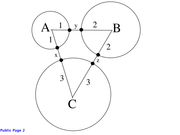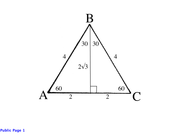sapuna wrote:Three circles with radii 1, 2 , 3, respectively, lie on the same plane. Do any of these circles intersect or lie completely within each other ?
1) IF you connect the centers of the circles, an equaliteral triangle is formed with a height of 2 square root of 3.
2) The distance between any two centers is less than 6.
Figure 1:

In the figure above, x, y and z represent the distances between circles A, B and C.
∆ABC is formed by joining the 3 centers.
Statement 1: If you connect the centers of the circles, an equaliteral triangle is formed with a height of 2 square root of 3.
Figure 2:

Thus, each side of ∆ABC = 4.
In figure 1, BC=4 only if z<0, implying that circles B and C intersect.
SUFFICIENT.
Statement 2: The distance between any two centers is less than 6.
It's possible that x=y=z=0, in which all 3 circles intersect.
It's possible that x=y=z=1/2, in which case none of the circles intersect.
INSUFFICIENT.
The correct answer is
A.
Private tutor exclusively for the GMAT and GRE, with over 20 years of experience.
Followed here and elsewhere by over 1900 test-takers.
I have worked with students based in the US, Australia, Taiwan, China, Tajikistan, Kuwait, Saudi Arabia -- a long list of countries.
My students have been admitted to HBS, CBS, Tuck, Yale, Stern, Fuqua -- a long list of top programs.
As a tutor, I don't simply teach you how I would approach problems.
I unlock the best way for YOU to solve problems.
For more information, please email me (Mitch Hunt) at
[email protected].
Student Review #1
Student Review #2
Student Review #3




















